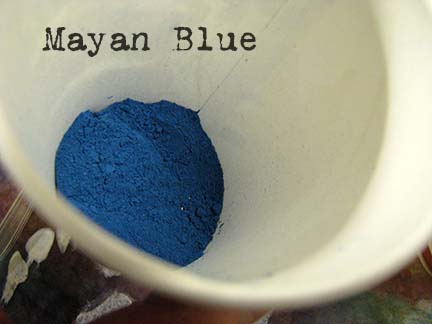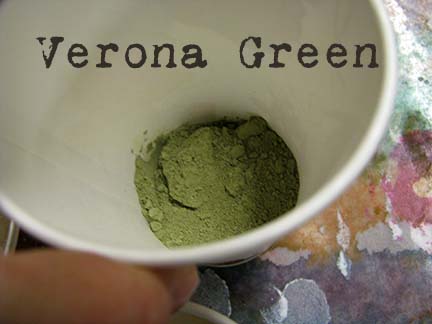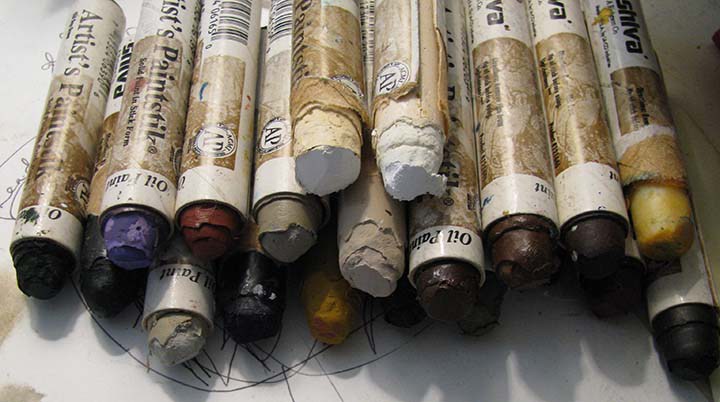Pretty Pigments Materials List
Materials List
- * Required
- ** Suggested NOT required. However, if you have these items already they will be a fun addition to the class.
- *** Personal items that are NOT purchased! The found objects, that you will be using in the 2D and 3D assignments should have a personal meaning to you. See the found objects list at the bottom of this page.
The only ochers and pigments required for this class are:
- * A yellow ocher of some type, and many of you may have a yellow ocher and/or clay in your back yard
- * An umber either Burnt or Raw (i.e., if you go with burnt umber then purchase raw umber to go with)
- * A sienna eitherBurnt or Raw (i.e., if you a raw sienna then purchase the burnt sienna to go with)
- *A red ocher or purple ocher
- ** Mayan Blue and/or Prussian Blue are suggestions NOT a requirement.
You may be wondering why I've required so few earth pigments.
Part of the joy of this class will be learning how to procure color from our own environment, i.e the ground beneath our feet!
A link to the online resource that I use and regularly, and as you can see they sell Mayan Blue which I will be using in the class but is NOT required for the class.
Required Items
Fabric
You will need a minimum of two yards of either cotton, silk, or linen fabric.
- *Thread to stitch with
- *Needles to hand sew with
- *String: a good stiff string for adding dimension and stability, I'm using hemp from the big box craft store.
- *Scissors
Paper
- *watercolor paper (cold press, buy the least expensive papers as it's easier to manipulate) ((NOTE I am using 12x18" sheets in this class, purchase what you can afford))
- **Rice Paper (absorbs earth pigments and beautifully)
- **bristol board (smooth or vellum surface)
- **brown craft paper
- **Khadi paper (a handmade paper from India that absorbs pigments, and natural dyes and in a gorgeous fashion!)
PFD cotton, silk, and linen fabrics.
Cotton and Silk fabrics that have been dyed with natural and/or synthetic dyes.
Examples of fabrics that are ready to be painted with earth pigments, ochers, and clay.
Emulsions, Binding Agents and Resists!
- *Soy Milk
- *Gel Medium
- *Matte Medium
- **Potato Starch
- **Gutta Resists (clear, black, white, etc.) or Blue Gel Glue (in the kids art section of any big box store)
Coloring Agents
- *charcoal, conte, grahite etc. (charcoal can come from your grill "IF" it's natural charcoal, and graphite can be from a pencil)
- *earth pigments, clay, ochers, etc.
- *cold wax (I use Dorland's cold wax buy the one you can best afford.
Earth Pigments painted onto silk Crepe de chine fabric onto which black gutta resist was first applied and then allowed to dry.
Wisdom Keepers 1 Detail 1. Earth Pigments, Cochineal, Cutch, Rust, and Copper Patina applied to cotton cloth that was then machine stitched for further visual interest.
Required Tools & Equipment
- *paint brushes, inexpensive boar bristle brushes work the best
- *stretcher frames (for stretching fabrics onto for painting)
- *thumb tacks
- *water container
- *respirator or dust mask (a better quality one) such as an N95.
- *gloves to protect your hands
- *studio shirt or smock (the earth pigments, ocher's, clays, stain EVERYTHING they come into contact with!!!)
Tools and Equipment Suggestions:
- Heavy duty needle with a large eye for pulling larger strings through fabric and paper.
- Staples, well just because of the marks they make when you get them wet and the fabric then proceeds to rust!
- Clothes pins or bull clamps, these might be handy when making the book signatures during the Bonus Assignment.
Various objects for creating texture and patterns.
Suggested Items
Fabric and Thread SUGGESTIONS
***These are not required materials but if you have them in your studio then you might enjoy incorporating them into your work
- Scrim/Cheese cloth,
- netting or silk organza
- bits of felt, ric rac, etc.
- crochet thread, or over heavy string
- hemp thread, or over heavy twine
One of the goals I have for you, as my student, is to teach you to see the everyday materials in your studios, lives, etc., in a different light.
Paper Suggestions
***these are NOT REQUIRED, however, I will be using a wide variety of papers during this class, many of which are reclaimed papers.
- Brown craft paper (paper bags)
- Rice paper (the kind use for gifts, calligraphy, etc.)
- Manilla envelopes
- Manilla folders
- Junk mail
- White envelopes harvested from the mail
- Newspaper
- Shipping tags, sticky dots, washi tape, and anything else I can harvest out of my mailbox!
Mixed Mediums Suggested Items
Please do NOT feel pressured to purchase the following items for this class, however, if you already own these items they can be used alongside the earth pigments, ochers, and clays to add further depth to your art cloth and art papers.
- **watercolor crayons (earth tones)
- **oil bars, shiva paintstiks, etc. (earth tones)
- **gold, or copper, or silver, leaf and/or foil
- **copper and/or rust patina
- **natural dye extracts (one or two minimum) ((You can darken fabrics using teas, coffee, or wood chips, if desired.))
Derwent Charcoal and Graphite Sticks.
Opaque Shiva Paintstiks
Water soluble oil pastel crayons.
Various types of metal leaf.
Various types of pencils: graphite, charcoal, conte, marks it all, etc.
Iridescent Shiva Paintstiks
Metallica and opaque markers and pens.
I will be using several types of oil bars, water color crayons, charcoal, and conte during this class. The colors I will be using are earth tones that will complement the earth pigments, clays, and ochers, I will be using.
As for hardness of the charcoal, conte, and graphite, I will be using a variety of hardness's to create different effects on both the fabrics and papers.
Using these items is a personal choice for each student. If you do not have any of these items on hand and choose to purchase some to experiment with I HIGHLY recommend purchasing student grade materials, in this instance the student grade materials will actually work better on the fabrics than their professional counterparts.
Found Objects
REMEMBER: The found objects list are suggestions ONLY; you do NOT have to have each item on the list. The items should be things that speak to your soul, not purchased 'stuff'. So if you have an affection for old door knobs, we will find a way to use them in your art!
This is a suggestions ONLY list as these found objects should have personal meaning to you!
- Sticks, twigs, leaves
- Rocks, I love smooth roundish rocks with speckles or lines of quartz in them
- Sea Shells, Sea Glass
- Bottle caps, tabs, etc.
- Rusty Bits
- Metal bits
- Old forks, spoons, maybe give them a good smash first to flatten them
- Baubles, buttons, and beads
- String, twine, yarn, upholstery cording, leather cords, etc.
Materials for creating armitures for 3D objects.
Various types of threads, strings, ropes, scissors, etc. to create enchanting fabrics.






















